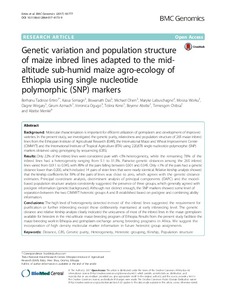| dc.contributor.author | Ertiro, B.T. |
| dc.contributor.author | Semagn, K. |
| dc.contributor.author | Das, B. |
| dc.contributor.author | Olsen, M. |
| dc.contributor.author | Labuschagne, M.T. |
| dc.contributor.author | Worku, M. |
| dc.contributor.author | Wegary, D. |
| dc.contributor.author | Azmach, G. |
| dc.contributor.author | Ogugo, V. |
| dc.contributor.author | Keno, T. |
| dc.contributor.author | Abebe, B. |
| dc.contributor.author | Chibsa, T. |
| dc.contributor.author | Menkir, A. |
| dc.date.accessioned | 2019-12-04T11:11:16Z |
| dc.date.available | 2019-12-04T11:11:16Z |
| dc.date.issued | 2017 |
| dc.identifier.citation | Ertiro, B.T., Semagn, K., Das, B., Olsen, M., Labuschagne, M., Worku, M., ... & Menkir, A. (2017). Genetic variation and population structure of maize inbred lines adapted to the mid-altitude sub-humid maize agro-ecology of Ethiopia using single nucleotide polymorphic (SNP) markers. BMC Genomics, 18(1), 777. |
| dc.identifier.issn | 1471-2164 |
| dc.identifier.uri | https://hdl.handle.net/20.500.12478/2391 |
| dc.description | Open Access Journal; Published online: 12 Oct 2017 |
| dc.description.abstract | Background
Molecular characterization is important for efficient utilization of germplasm and development of improved varieties. In the present study, we investigated the genetic purity, relatedness and population structure of 265 maize inbred lines from the Ethiopian Institute of Agricultural Research (EIAR), the International Maize and Wheat Improvement Centre (CIMMYT) and the International Institute of Tropical Agriculture (IITA) using 220,878 single nucleotide polymorphic (SNP) markers obtained using genotyping by sequencing (GBS).
Results
Only 22% of the inbred lines were considered pure with <5% heterogeneity, while the remaining 78% of the inbred lines had a heterogeneity ranging from 5.1 to 31.5%. Pairwise genetic distances among the 265 inbred lines varied from 0.011 to 0.345, with 89% of the pairs falling between 0.301 and 0.345. Only <1% of the pairs had a genetic distance lower than 0.200, which included 14 pairs of sister lines that were nearly identical. Relative kinship analysis showed that the kinship coefficients for 59% of the pairs of lines was close to zero, which agrees with the genetic distance estimates. Principal coordinate analysis, discriminant analysis of principal components (DAPC) and the model-based population structure analysis consistently suggested the presence of three groups, which generally agreed with pedigree information (genetic background). Although not distinct enough, the SNP markers showed some level of separation between the two CIMMYT heterotic groups A and B established based on pedigree and combining ability information.
Conclusions
The high level of heterogeneity detected in most of the inbred lines suggested the requirement for purification or further inbreeding except those deliberately maintained at early inbreeding level. The genetic distance and relative kinship analysis clearly indicated the uniqueness of most of the inbred lines in the maize germplasm available for breeders in the mid-altitude maize breeding program of Ethiopia. Results from the present study facilitate the maize breeding work in Ethiopia and germplasm exchange among breeding programs in Africa. We suggest the incorporation of high density molecular marker information in future heterotic group assignments. |
| dc.description.sponsorship | Africa Biosciences Challenge Fund |
| dc.description.sponsorship | Department of Foreign Affairs and Trade, Australia |
| dc.description.sponsorship | Bill & Melinda Gates Foundation |
| dc.description.sponsorship | Department for International Development, United Kingdom |
| dc.description.sponsorship | Swedish International Development Cooperation Agency |
| dc.format.extent | 1-11 |
| dc.language.iso | en |
| dc.subject | Distance |
| dc.subject | Maize |
| dc.subject | Population Structure |
| dc.subject | Gbs |
| dc.subject | Genetic Purity |
| dc.subject | Heterogeneity |
| dc.subject | Heterotic Grouping |
| dc.subject | Kinship |
| dc.title | Genetic variation and population structure of maize inbred lines adapted to the midaltitude sub-humid maize agro-ecology of Ethiopia using single nucleotide polymorphic (SNP) markers |
| dc.type | Journal Article |
| dc.description.version | Peer Review |
| cg.contributor.crp | Agriculture for Nutrition and Health |
| cg.contributor.crp | Maize |
| cg.contributor.affiliation | Ethiopian Institute of Agricultural Research |
| cg.contributor.affiliation | University of Alberta |
| cg.contributor.affiliation | International Maize and Wheat Improvement Center |
| cg.contributor.affiliation | University of the Free State |
| cg.contributor.affiliation | International Institute of Tropical Agriculture |
| cg.coverage.region | Africa |
| cg.coverage.region | East Africa |
| cg.coverage.country | Ethiopia |
| cg.isijournal | ISI Journal |
| cg.authorship.types | CGIAR and developing country institute |
| cg.iitasubject | Maize |
| cg.journal | BMC Genomics |
| cg.howpublished | Formally Published |
| cg.accessibilitystatus | Open Access |
| local.dspaceid | 92341 |
| cg.targetaudience | Scientists |
| cg.identifier.doi | http://dx.doi.org/10.1186/s12864-017-4173-9 |

